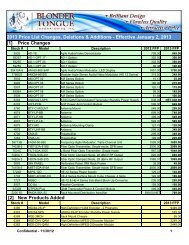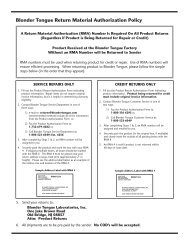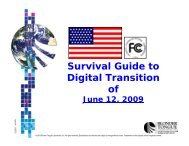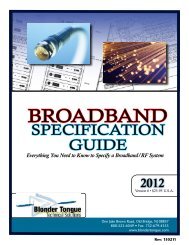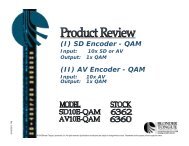Functional Block Diagram - Blonder Tongue Laboratories Inc.
Functional Block Diagram - Blonder Tongue Laboratories Inc.
Functional Block Diagram - Blonder Tongue Laboratories Inc.
Create successful ePaper yourself
Turn your PDF publications into a flip-book with our unique Google optimized e-Paper software.
Broadband Specification Guide<br />
CATV Terms & Definitions<br />
Termination<br />
Resistive device at end of distribution line or unused outputs of equipment<br />
to avoid reflections (ghost).<br />
Thru-Line Loss<br />
Insertion loss of a tapoff.<br />
Tilt Control<br />
Circuit on an amplifier to compensate for cable slope. Also referred to as<br />
slope control.<br />
Transmitter<br />
In a fiber optic system, the device which converts a modulated<br />
electrical signal into an optical signal for transmission through a fiber. A<br />
transmitter typically consists of a light source (LED or diode laser) and<br />
driving electronics.<br />
Transponder<br />
A frequency converter (translator) aboard a satellite that changes the<br />
uplink signal to the downlink signal and provides amplifications. Typical<br />
C-Band domestic satellites have 24 transponders.<br />
Trap<br />
A device used to attenuate specific frequencies of channels.<br />
Triple Beat Distortion<br />
Spurious signals generated when three or more carriers are passed<br />
through a nonlinear circuit. The spurious signals are sum and difference<br />
products of any three carriers, sometimes referred to as "beats." Triple<br />
beat distortion is calculated as a voltage addition.<br />
Trunk<br />
1. One telephone communication channel between (a) two ranks of<br />
switching equipment in the same central office, (b) between central<br />
office units in the same switching center, or (c) between two switching<br />
centers. A trunk is for the common use of all calls of one class between<br />
its two terminals.<br />
2. A sub-system within a trunk plus feeder designed CATV system which<br />
provides somewhat limited, arterial distribution of signals broadly<br />
across the CATV service area.<br />
Trunk Plus Feeder Design (trunk/feeder)<br />
A technique for designing CATV systems which involves two or more<br />
transmission levels, applied within different sub-systems of the same<br />
system. Generally requires some significant amount of paralleling<br />
cable placement.<br />
TVRO<br />
An abbreviation for "television receive only." Defines a facility which can<br />
include antennas, preamplifiers, and receivers for the reception only of<br />
television signals from a geostationary satellite in space.<br />
Twinlead<br />
A balanced transmission line usually of 300 ohm impedance.<br />
Two-way<br />
Describing a transmission system, which can transport signals in both<br />
directions simultaneously.<br />
Two-way Filter<br />
A combination of low and high pass filters to subdivide spectrum in a<br />
CATV system, allocating some spectrum for transmission in one direction,<br />
and some spectrum for transmission in the opposite direction.<br />
T-1 Carrier System<br />
A 24-channel, transistorized, time-division, pulse-code modulation, voice<br />
carrier used on exchange cable to provide short-haul trunks. Uses two<br />
pairs, in one or two cables, for two directions of transmission. Requires<br />
regenerative pulse repeaters at 6000 feet intervals.<br />
UHF<br />
Ultra High Frequencies TV channels 14-69 (470-806 MHz)<br />
Ultra-high Frequency (UHF)<br />
The radio spectrum between 300 and 3,000 MHz. The term UHF is also<br />
commonly used to denote standard television channels 14 through 69,<br />
which fall within this spectrum.<br />
Ultraviolet<br />
Electromagnetic radiation with wavelengths between about 40 and 400<br />
nanometers. Radiation between 40 and 200 nm is termed "vacuum<br />
ultraviolet" because it is absorbed by air and travels only through a<br />
vacuum. The "near" ultraviolet has wavelengths close to those of visible<br />
light; the "far" ultraviolet has shorter wavelengths.<br />
Underground Cable<br />
Cable installed in subsurface conduits terminating at intervals in manholes,<br />
thus permitting the placing, replacing, or removal of cables at will.<br />
Uplink<br />
Transmission from earth to a satellite.<br />
Usable Gain (See Gain, usable)<br />
VHF<br />
Very High Frequencies TV channels 2 thru 13 and FM (54-216 MHz).<br />
Velocity of Light<br />
The velocity of light in a vacuum is 2,997,925. meters per second or<br />
186,280 miles per second. For rough calculations the figure of 3,000,000<br />
meters per second is generally used.<br />
Very High Frequency (VHF)<br />
The radio spectrum between 30 and 300 MHz. The term VHF is also<br />
commonly used to denote standard television channels 2 through 13,<br />
which fall within this spectrum.<br />
Vestigial Side Band (VSB)<br />
In amplitude-modulated transmissions, a portion of only one sideband<br />
of a modulated carrier. The modulated carrier is passed through a filter<br />
having a graduated cut-off characteristic near the carrier frequency. A<br />
substantial portion of the modulated carrier is suppressed in this fashion.<br />
94



